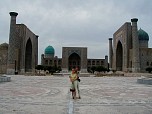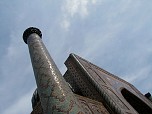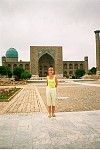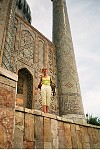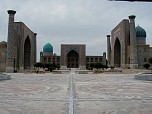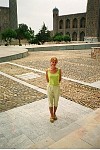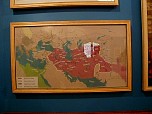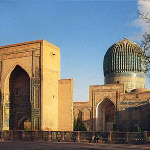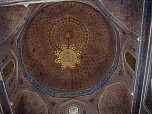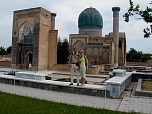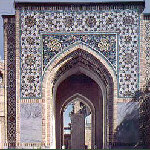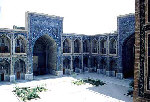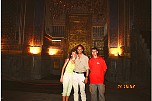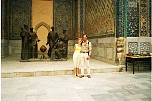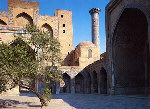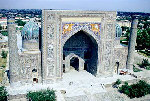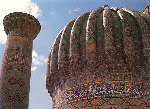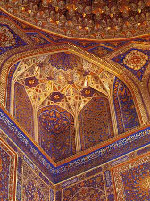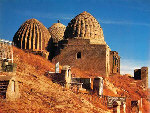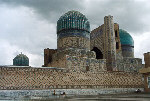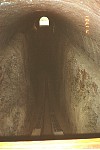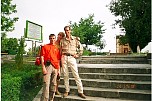|
Samarkand is situated in the valley of the river Zarafshan.
It is the second largest city of Uzbekistan and is of the same age
as the city of Babylon or Rome. The history of Samarkand is
about 2,500 years old and has witnessed a lot of upheavals during
the times of Alexander the Great, the Arabic Conquest, Genghis-Khan
Conquest and lastly Tamerlane's. Hence, the culture of Samarkand
was developed and mixed together with the Iranian, Indian, Mongolian
and a bit of the Western and Eastern cultures. Majestic and
beautiful city Samarkand has a marvelous and attractive power. Poets
and historians of the past called it "Rome of the East, The
beauty of sublunary countries, The pearl of the Eastern Moslem World".
Its advantageous geographical position in Zarafshan valley put Samarkand
to the first place among cities of the Central Asia.
In 1404 Temur the Great ordered to build the mausoleum
Guri-Emir (Tomb of Emir) for his loving grandson, Mukhammad Sultan.
With time, the mausoleum became the family crypt of the Temurids
dynasty. Majesty and lightness of architectural lines and shapes,
richness of the multi-colored mosaic - all this makes the mausoleum
a unique monument of Central Asian architecture. Next to Tamerlane,
there are the graves of his sons Shakhrukh and Miranshakh and his
grandsons Mukhammad-sultan and Ulugbek. There are two more Temurids
tombs nearby: the Mausoleum Rukhabad, built for Sheikh Burhanuddin
Sagharji in the 1380s and the modest-sized Mausoleum Ak-Saray built
in 1470s for the last of Temurids.
One of the holy sites attracting a great number of pilgrims is the
memorial and research complex of the Islamic scholar and theologian
Imam Ismail al-Bukhari. For a millennium, the whole Muslim world
has had deep respect for Imam-al-Bukhari. His works are considered
to be an achievement of theological thought, which ranks the second
after the holy Koran in its value. This collection contains 600,000
hadiths entitled "Al-Jami as -Sahih" or "Sincere
Book". The scholar's grave is located in a village not far
from Samarkand. His tomb is a holy place attracting Muslim pilgrims.
The complex is built on his tomb and includes Mausoleum al-Bukhari,
a mosque and a library.
The Registan was the heart of the ancient Samarkand. The word Registan
means "a sandy place." It existed long before the Mongol
invasion as a city trade and artisan square. It is the point of
six roads, which ran from the city gates. From this very place to
the strains of copper trumpets public criers announced citizens
about new orders of the ruler.
Under Tamerlane's rule the Registan became the city's square and
during the time of Ulugbek it was adorned with majestic buildings.
The entire group of buildings, including the madrassas, khanakas,
mosques and caravan-sarais, was constructed during his time.
Registan is surrounded from three sides with majestic buildings:
Madrassa Ulugbek (1417 - 1420), Sher Dor (1619 - 1636), Tilla Kari
(1647 - 1660). The Ulugbek Madrassa is the highest religious institution,
a kind of university of the Middle Ages. In ancient manuscripts
it was mentioned that Ulugbek himself taught mathematics. The Ulugbek
Madrassa has its majestic portal with lancet arch facing the square.
The corners are flanked by the high well-proportioned minarets,
which were never used by muedzins, there were said instead to hold
up the sky.
Two monumental buildings were constructed in the 17th c. on Registan
- Madrassa Sher-Dor and Tilla-Kori. They are distinguished by the
imposing sizes and luxury of decoration, though in terms of the
architectural value they nevertheless give away to their prototype,
Madrassa Ulugbek. The most considerable of all madrassas of the
17th c. is Sher-Dor which means "Building with lions".
It was built for almost 17 years under the project of emir Yalangtosh,
the Governor of Samarkand. Ten years later, during the same governor,
the Madrassa Tilla Kori was constructed, closing Registan from the
north. The name Tillya-Kori means "trimmed with gold".
Madrassa Tilla Kori, apart from its primary goal (training students)
executed the role of the main mosque.
On the southeast slope of Afrosiab one of the famous ancient architectural
ensembles of Samarkand is situated - the burial vault Shahi Zinda.
It consists of eleven mausoleums, which were built one after another
in the 14-15th c. Some of these buildings with blue cupolas, majolica
on high portals, ornamented stone arches, ornaments of piles have
been restored by the architects and folk foremen.
The entrance portal of Shahi Zinda, which crowns the whole ensemble,
is the latest construction. The inscription on the portal says:
"This majestic building is founded by Abdulazazkhan, son of
Ulugbek-Guragan, son of Shakhrukh, son of Amir Temur - Guragan in
883" (1434 AD). Having mounted thirty-six steps of the ancient
stairway, the visitor finds himself in an open gallery. Here on
the left and on the right are situated the burial vault - mausoleums
of Temur's close relatives, including his wife Tuman-aka and sister
Shirin - bika-aka. The gallery finishes with a round yard with a
vaulted arch.
Under it on the right there is an ancient carved door, which leads
to the most ancient construction of Shahi Zinda ensemble - mausoleum
Kussam ibn-Abbas. He was declared "saint" for the sermon
and setting up of Islam in Samarkand after its seizure by Arabs.
The keepers of Shahi Zinda will for sure tell the tourists the ancient
legend that Kussam ibn-Abbas who lived here, one day, after finishing
the sermon, removed his own head from shoulders, took it in his
arm-pits and hid through a narrow slot in a cave, where he is still
living ostensibly nowadays. That is where the name "Shahi Zinda"
which means "A Living King" comes.
As a whole, the architectural ensemble Shahi Zinda represents a
unique museum of glazed decor of the 14-15th c. One can find here
glazed and carved terracotta, wonderful samples of the set mosaic,
large mosaic made of glazed bricks.
Another outstanding architectural construction of medieval Samarkand
is the main mosque Bibi Khanum. Its construction began in 1399,
after Temur’s victorious campaign on India. The mosque had
been constructed in five years. By Temur’s plan the mosque
Bibi Khanum was supposed to eclipse all that he saw in other countries.
The architects, artists, foremen and craftsmen from many countries
of the East were involved in construction. Two hundred stone-carvers
from Azerbaijan, Fars, Indostan and other countries worked in the
mosque and five hundred workers in the mountains near Penjikent,
extracting and carving the stones and sending them to Samarkand.
The construction was not yet completed, when Temur again set off
for one of his campaigns. After returning to the capital, he went
immediately to look on the new mosque. The grandiose buildings occupied
a rectangular court yard of 130x102 meters. On its western side
towered the main mosque, on the northern and southern - small mosques.
The spacious internal courtyard was covered with marble plates and
enclosed with covered gallery for devout. The entrance to the courtyard
was designed as a high portal with two round minarets fifty meters
high. The facade of the main mosque was also decorated with majestic
portal with two minarets.
The walls of all premises were richly decorated from outside with
multi-colored glazed bricks which formed whimsical geometrical ornament
and religious sayings. The magnificent and rich furnishing of internal
premises consists of facing with glazed mosaic, carved marble and
gilt patterns. However, Temur was dissatisfied by construction and
in anger ordered to seize the nobles - Khoja Makhmud David and Muhammad
Jeld, who were supervising construction. They were sentenced to
death and hung up behind the channel Siab, at the foot of Chupanata.
Ulugbek (Temur’s grandson) ruled the country for 40 years.
During his rule Samarkand became one of the scientific centers of
world during the Middle Ages. In Samarkand Ulugbek created a scientific
school, which untied outstanding astronomers and mathematicians.
Ulugbek was the founder of the unique construction of the observatory
(1428-1429).
There was a gigantic marble sextant there, its radius was 40.212
meter and the length of the arc is 63 meters. The instrument was
made in all details and was very precise. It was used to determine
the coordinates of the Sun, the Moon and other planets. Ulugbek
created the astronomic catalogue "Stars Tables". The preciseness
of Samarkand astronomers' observatory surprises, because they did
not use any optical instruments, only their eyes
|
|

